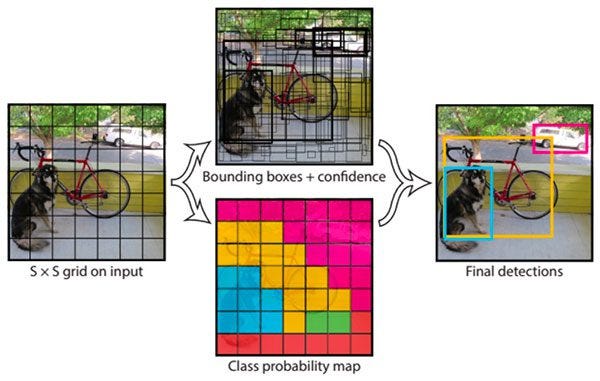Discover Pandipedia
Pandipedia is the world's first encyclopaedia of machine generated content approved by humans. You can contribute by simply searching and clicking/tapping on "Add To Pandipedia" in the answer you like. Learn More
Expand the world's knowledge as you search and help others. Go you!

According to the text, M. Louis de Montpensier was of 'the most violent temper'[1]. On one occasion, while at the siege of Rochelle, M. de Serre was captured and brought before Montpensier[1]. M. de Serre stated he was holding the place 'For the King', in response, Montpensier 'flung a silver candlestick at his head'[1].
Let's look at alternatives:
- Modify the query.
- Start a new thread.
- Remove sources (if manually added).
- Request a manual search from our human research team.

YOLO, which stands for 'You Only Look Once,' revolutionized object detection by treating it as a regression problem rather than a classification task. This unique approach allows YOLO to utilize a single convolutional neural network to predict bounding boxes and associated probabilities simultaneously, resulting in faster and more accurate detection compared to traditional methods that relied on multi-stage pipelines[3][4].
The algorithm achieves remarkable speed, processing images at about 45 frames per second while maintaining high mean Average Precision. This efficiency has made YOLO a top choice for real-time applications across various fields, including autonomous driving, surveillance, and medical imaging[1][2].
Let's look at alternatives:
- Modify the query.
- Start a new thread.
- Remove sources (if manually added).
- Request a manual search from our human research team.
Get more accurate answers with Super Search, upload files, personalised discovery feed, save searches and contribute to the PandiPedia.

“This Journal… proves the existence of such under currents”
Unknown[1]
“…those intrepid men who for us cheerfully brave the fury of the waves, and the rage of battle”
Rev. Walter Traill[1]

“Even you, my friends, who are employed inthe execution of this work, are objects of regard and gratitude”
Rev. Walter Traill[1]
“...safety and life shall spring from danger and death”
Rev. Walter Traill[1]
"Even you, my friends, who are employed in the execution of this work, are objects of regard and gratitude."
Rev. Walter Traill[1]
Let's look at alternatives:
- Modify the query.
- Start a new thread.
- Remove sources (if manually added).
- Request a manual search from our human research team.

Snake Plant (Sansevieria)
Known for its drought tolerance and adaptability to various light levels, including low light[2][3][8].

Spider Plant
Easy to grow, tolerating neglect, low light, and varying watering frequencies, while also helping to purify the air[2][3][8].
Pothos (Devil’s Ivy)
A rapid grower that prospers in low light and is highly tolerant of irregular watering[2][3][8].
Peace Lily
Notably easy to care for, requiring moderate watering and able to thrive in low light conditions[1][2][3].

Cast Iron Plant
Famously indestructible, this plant thrives in low light and requires very little water[1][3][10].


Philodendron
Appreciates low to medium light and infrequent watering, making it ideal for beginners[13][14].

Rubber Plant
Easygoing and tolerant of low light, this plant has large, glossy leaves[2][8][13].

Jade Plant
A succulent that thrives in bright light and can endure long periods without water[1][7][14].

Chinese Evergreen
Known for its colorful leaves, this plant does well in low light and needs infrequent watering[1][2][13].

Prayer Plant
Features unique leaves that move in response to light, thriving in low light and needing regular humidity[9][14].

Bird of Paradise
While it prefers bright light, it can tolerate less ideal conditions and is relatively easy to care for[8].




Fiddle Leaf Fig
Popular for its large, glossy leaves, it prefers bright light but can tolerate being underwatered[9][14].

Boston Fern
Prefers a humid environment and indirect light, but is generally easy to care for[7][15].

Maranta Red Prayer Plant
Adapts well to various lighting conditions, needing moderate humidity and watering[15].


Tillandsia (Air Plants)
Growing without soil, they only need regular misting or dunking in water[5][14].
Let's look at alternatives:
- Modify the query.
- Start a new thread.
- Remove sources (if manually added).
- Request a manual search from our human research team.

A nice side dish for carrot soup could include crusty French bread, which is perfect for dipping due to its crunchy exterior and soft interior[2]. Garlic bread is also a great option, offering an aromatic and buttery flavor that complements the soup well[1]. Additionally, a Caesar salad provides a fresh and crisp contrast[1], while a mixed green salad adds vibrant elements[2]. Other excellent choices are mashed potatoes, which balance the sweetness of the soup, and cornbread, known for its subtly sweet and moist texture[3]. Grilled cheese sandwiches or baked cheese and veggie quesadillas provide a hearty contrast, making them satisfying pairings as well[3]. For a unique option, consider homemade flatbreads to mop up the soup[6], or even fried paneer cheese cubes for a crispy, vegetarian bite[4].
Let's look at alternatives:
- Modify the query.
- Start a new thread.
- Remove sources (if manually added).
- Request a manual search from our human research team.

The core components of a computer include the Central Processing Unit (CPU), memory (RAM), and storage devices. The CPU, often referred to as the 'brain' of the computer, performs calculations and executes instructions, containing sub-components such as the Arithmetic Logic Unit (ALU), Control Unit (CU), and registers[1][2].
Memory is typically divided into Random Access Memory (RAM) for temporary data storage and Read-Only Memory (ROM) for permanent instructions[6]. Storage devices, like Hard Disk Drives (HDDs) and Solid-State Drives (SSDs), are used for long-term data retention[4][5]. Together, these components enable the computer to perform a wide range of tasks efficiently.
Let's look at alternatives:
- Modify the query.
- Start a new thread.
- Remove sources (if manually added).
- Request a manual search from our human research team.
Get more accurate answers with Super Search, upload files, personalised discovery feed, save searches and contribute to the PandiPedia.

Setting effective goals is essential for personal and professional development. In this context, SMART goals provide a structured framework that enhances clarity and encourages successful outcomes. The SMART acronym stands for Specific, Measurable, Achievable, Relevant, and Time-bound, and each component plays a crucial role in goal attainment.
Specificity in Goal Setting
A well-defined goal is clear and straightforward. It eliminates ambiguity by specifying what needs to be accomplished. For instance, instead of saying, “I want to improve productivity,” a specific goal would be, “Increase productivity by 20% within the next quarter through better time management strategies”[11]. Addressing questions such as “What exactly do I want to achieve?” and “Who will be involved?” helps in crafting specific goals[9].
Measurable Goals
To ensure progress, goals must be measurable. This allows individuals to track their advancements and evaluate success. A measurable goal provides clear criteria for success, answering questions like “How will I know when the goal is accomplished?” and “What metrics will I use?” For example, instead of setting a vague aim to “get fit,” a measurable goal might be, “Exercise for 30 minutes, five days a week, for the next two months”[6]. By quantifying the objective, a sense of achievement can be fostered, promoting ongoing motivation.
Achievability of Goals
An achievable goal is realistic and attainable within the given resources and constraints. Setting goals that are too ambitious can lead to frustration and demotivation[10]. Therefore, it is vital to assess whether the goal is within reach, which involves considering available resources, skills, and time[12]. For example, “I will read one book a month” is more achievable than “I will read fifty books this year” if time and capacity are limited[6].
Relevance to Overall Objectives
Goals should align with broader life aspirations or organizational objectives to maintain motivation and relevance. A goal that resonates personally increases commitment. Therefore, one must ask, “Why is this goal important?” and “Does it tie into my long-term aspirations?” For example, a professional might set a goal to “Expand my professional network by attending one industry conference each quarter”[9]. Such relevancy ensures that the goal contributes meaningfully to personal or organizational growth.
Time-Bound Goals
Setting a timeline is essential as it creates urgency and accountability. Time-bound goals help prevent procrastination and push individuals to prioritize tasks effectively. Questions such as “When do I want to achieve this goal?” and “What deadlines can I set for interim milestones?” assist in establishing a clear timeframe[11]. An example of a time-bound goal is, “I will complete my project proposal by April 15,” which allows for adequate planning and execution[9].
Benefits of Using SMART Goals
The implementation of SMART criteria offers numerous advantages:
Enhanced Focus: SMART goals provide clarity and prevent distraction by defining explicit targets.
Increased Motivation: The structured approach of SMART goals can boost enthusiasm for achieving objectives as they become straightforward and actionable[12].
Improved Decision-Making: Specific goals allow for better resource allocation and prioritization within efforts, leading to more informed decisions[11].
Greater Accountability: With measurable and time-bound components, progress can be tracked effectively, holding individuals accountable for their actions[11][12].
Common Pitfalls in Setting SMART Goals
While SMART goals have proven effective, it's important to avoid certain pitfalls:
Setting Uninspiring Goals: Goals should be personally meaningful. Setting targets influenced solely by external pressures may lead to disengagement[11].
Neglecting to Reevaluate Goals: Regularly reviewing and adjusting goals according to progress and changing circumstances is crucial for continued growth and relevance[12].
Becoming Overly Focused on Metrics: While measurement is important, an obsessive focus on numbers can detract from the overall goal and lead to burnout[10].
Practical Steps for Implementing SMART Goals
To effectively implement SMART goals, consider the following steps:
Define Specific Goals: Clearly articulate what you aim to achieve and outline the actions necessary to get there.
Incorporate Measurable Criteria: Establish metrics to gauge your progress and celebrate milestones along the way.
Ensure Goals are Achievable: Assess your resources and capacity to ensure the goals you set are realistic yet challenging.
Align Goals with Relevance: Check that your goals fit within your larger life aspirations or the broader objectives of your organization.
Set Time-Bound Deadlines: Assign specific deadlines to your goals to enhance focus and encourage timely execution[11][12].
Conclusion
Setting SMART goals is an effective strategy for anyone looking to increase productivity and achieve significant results in their personal and professional lives. By focusing on the aspects of specificity, measurability, achievability, relevance, and time-bound elements, individuals can structure their goals effectively, leading to growth and success. Embracing this framework not only provides direction but also enhances motivation and accountability on the journey toward achievement.
Let's look at alternatives:
- Modify the query.
- Start a new thread.
- Remove sources (if manually added).
- Request a manual search from our human research team.

Xeriscaping is the process of landscaping or gardening that reduces or eliminates the need for irrigation. It is particularly promoted in regions lacking accessible, plentiful, or reliable supplies of fresh water and has gained acceptance in other areas where access to irrigation has become limited. The practice emphasizes the use of plants that naturally suit the local climate and aims to minimize water loss through evaporation and runoff. Xeriscaping differs from traditional landscaping by focusing on water conservation rather than solely selecting native plants[1].
This approach can provide greenspaces that require low maintenance and irrigation, promote biodiversity, and reduce environmental pollution. However, public perception of xeriscaping can be negative due to misconceptions that it results in unattractive landscapes dominated by cacti and gravel. Educational efforts have shown potential to improve public attitudes towards xeriscaping[1].
Xeriscaping strategies have been linked to benefits such as reduced water usage (up to 60% compared to regular lawns), lower costs for maintenance and landscaping, and mitigation of urban heat island effects. It can also provide habitats for wildlife and enhance biodiversity through practices like pocket forests and rain gardens, which help manage stormwater runoff[1].
Let's look at alternatives:
- Modify the query.
- Start a new thread.
- Remove sources (if manually added).
- Request a manual search from our human research team.

In the Lex Fridman podcast with Elon Musk, DJ Saw, Matthew McDougall, Bliss Chapman, and Nolan Arbaugh, they discuss Neuralink's achievements and future goals. Elon Musk talks about the historic milestone of implanting a Neuralink device in a human brain, acknowledging the significant advances in technology and what that means for the future of human-computer interfaces[1].
DJ Saw elaborates on the technical aspects of Neuralink, including the challenges and innovations involved in creating and optimizing the device, emphasizing its potential impact on people with disabilities[1]. Matthew McDougall, the head neurosurgeon, discusses the surgical process and the intricacies involved in safely implanting the device, highlighting its precision and low-risk nature[1].
Bliss Chapman, the brain interface software lead, delves into the software components and the continuous improvements being made, particularly focusing on user experience and decoding strategies to enhance performance and usability for users like Nolan[1].
Nolan Arbaugh, the first human with a Neuralink device, shares his journey from his accident to the present, his positive mindset, and the newfound independence the device has provided. He describes the transformative experience of controlling a cursor with his mind and the excitement of setting and breaking world records in tasks like the web grid game[1].
Let's look at alternatives:
- Modify the query.
- Start a new thread.
- Remove sources (if manually added).
- Request a manual search from our human research team.
The integration and effective operation of AI agents within user interfaces (UIs) present a variety of challenges. As AI technology advances, understanding these challenges is critical for improving user-agent interactions across diverse platforms. This report synthesizes key issues identified in recent studies regarding UI navigation difficulties faced by AI agents.
Limitations in Data and Training

One of the significant hurdles in developing efficient UI navigation capabilities for AI agents is the reliance on datasets that often do not encompass the multifaceted nature of real-world tasks. Many existing AI models are trained on datasets that center around simple, app-specific tasks, hindering their performance in scenarios requiring cross-application navigation where workflows are complex and varied[5]. The lack of comprehensive datasets designed for cross-application navigation significantly impairs the development of robust AI agents[5].
The fine-tuning of AI models on task-specific demonstrations is essential for enhancing their success rates. Reports indicate that without this fine-tuning, tasks in desktop applications may only achieve success rates as low as 12%, while mobile applications fare slightly better at 46%[4]. This stark contrast underscores the necessity of high-quality training data for effective model performance.
Furthermore, the challenge of ensuring consistent and accurate annotation across multiple applications is substantial, as inconsistent human annotator contributions can result in ambiguities and errors that affect the overall performance of AI navigation systems[4].
Technical Limitations and Functional Understanding

Another pressing issue relates to the technical capabilities of AI agents themselves. Many models struggle to comprehend images and graphical elements accurately. The ability of AI to perform Optical Character Recognition (OCR) and effectively ground its understanding in user interfaces is often inadequate. Issues arise when AI needs to locate and interpret designated text or UI components due to poor grounding abilities[1]. Furthermore, essential non-textual information such as icons, images, and spatial relationships are challenging for AI systems to process and convey effectively through text alone[7][8].
AI models often lack a comprehensive understanding of website widgets and their functional mechanisms, limiting their ability to interact appropriately with dynamic GUI elements[1]. The reliance on visual signals for complex tasks can also be problematic; for instance, tasks reliant on animations or intricate visual cues are frequently mismanaged, as current AI models focus primarily on textual instructions rather than visual interpretative skills[3].
Complexity of Task Execution

High-level planning and execution of tasks within UIs represent a significant challenge for AI agents. Current models face difficulties reconstructing procedural subtasks from visual conditions without adequate language descriptions, leading to poor performance in high-level planning benchmarks[3]. Action execution remains an area of concern as well, where models often fail to execute actions such as clicking and dragging with the required precision, thus missing critical interactions necessary for successful navigation[3][4].
Moreover, the high openness of some tasks adds to the complexity, as users may approach these tasks in various ways. Capturing a specific sequence of actions during data collection may fail to represent all possible execution strategies, limiting the agent's flexibility in addressing real-world scenarios[5].
Generalization and Domain Transfer

The ability of AI agents to generalize their learning and effectively adapt to new scenarios is crucial for their application in diverse environments. However, current models considerably struggle with generalizing knowledge to unseen applications, tasks, and devices[5]. This limitation is exacerbated by the focus on web-based interfaces in existing research, leading to deficits in robustness across various platforms, including desktop and mobile operating systems[2].
AI agents also face challenges in navigating dynamic GUI content, where unexpected elements like pop-up advertisements can disrupt task flow. This issue demonstrates a broader gap in how AI handles dynamic sequential tasks without prior annotated keyframes or operational histories[2].
Modal Alignment and Precision

For effective UI navigation, alignment across different modalities is essential. Many models experience difficulties in accurately correlating entities between various modalities, leading to imprecise bounding boxes for GUI elements. Such precision issues present significant complications when dealing with tasks that demand accurate interaction with UI components[8].
Additionally, the transformation of essential details like icons and their spatial relationships into text embeddings can lead to misrepresentation. This loss of critical information hampers the AI's decision-making capabilities and ability to engage with UIs effectively[8].
Conclusion
The challenges faced by AI agents in UI navigation are multifaceted, involving limitations in training data, technical capabilities, task execution complexity, generalization issues, and precision in modal alignment. As AI continues to evolve, addressing these challenges is imperative for enhancing the functionality and effectiveness of agents in navigating complex user interfaces across various platforms. Through continued research and innovation, the goal of achieving seamless human-agent interactions can be realized, paving the way for more sophisticated and adaptable AI solutions in everyday applications.
Let's look at alternatives:
- Modify the query.
- Start a new thread.
- Remove sources (if manually added).
- Request a manual search from our human research team.






:max_bytes(150000):strip_icc()/grow-dracaena-marginata-indoors-1902749-3-d5d6beaeb1dd4e82af786fc61ec8047d.jpg)
:max_bytes(150000):strip_icc():format(webp)/_DSC58741-297432ef09df40a9a700eca69b9ab1ef.jpg)

:max_bytes(150000):strip_icc():format(webp)/AloeVera-f3f0e1982e0f4f138095bd778ce1194b.jpg)
:max_bytes(150000):strip_icc():format(webp)/best-indoor-trees-4148340-15-a8c16d5a1a66418a836a0580bb98fb07.jpeg)





:max_bytes(150000):strip_icc():format(webp)/kararileycalathea-35-2549b4bf97614db19e284d135d0194da.jpg)




:max_bytes(150000):strip_icc():format(webp)/how-to-grow-echeveria-4778458-recirc-a7236005fe724978963543655e0f3324.jpg)
:max_bytes(150000):strip_icc():format(webp)/Echeveria-6a05983995f846328e4828403b4c3d96.jpg)
:max_bytes(150000):strip_icc():format(webp)/GettyImages-1091872542-ed0a1e37a9b14890ab4af9dbec6ff239.jpg)